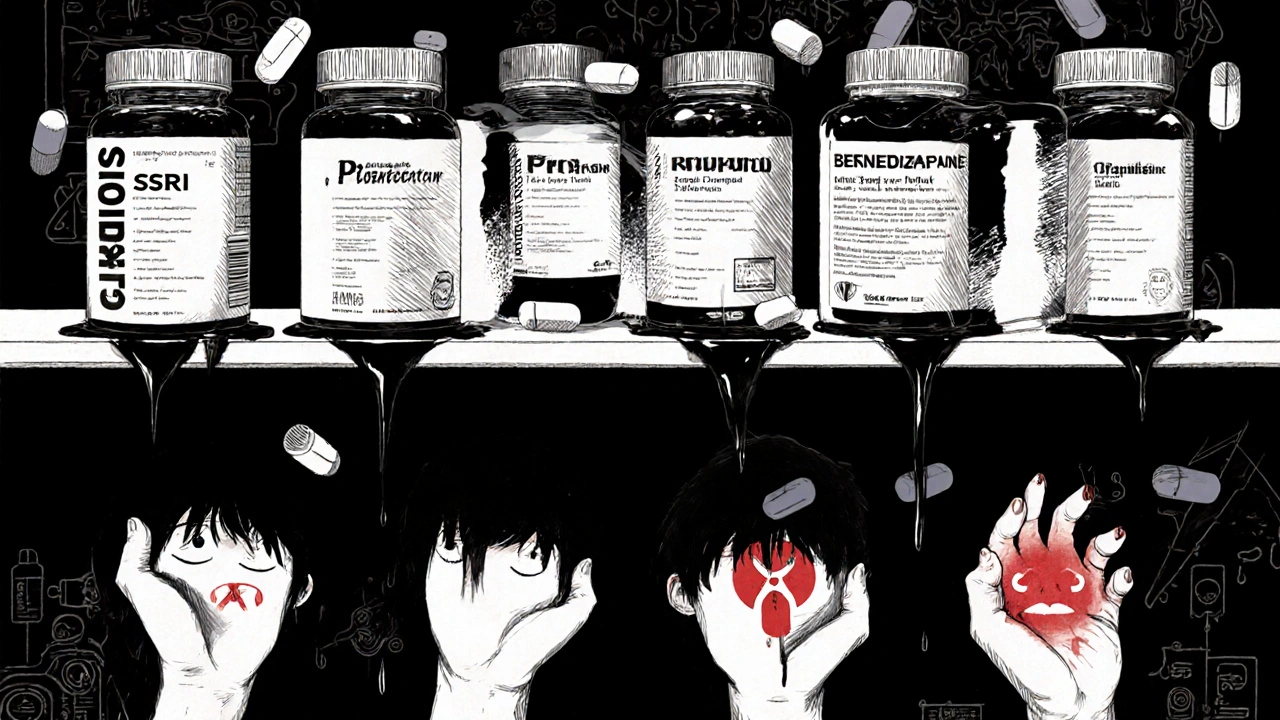Medication Side Effect Tolerance Calculator
Understand why some side effects fade while others persist. Input your medication type and side effect to see typical tolerance timelines based on clinical studies.
Tolerance Timeline Result
Select a medication class and side effect to see tolerance timeline details.
Have you ever started a new medication and felt awful for the first few days-nausea, dizziness, fatigue-only to wake up one morning and realize those symptoms are gone? You might think you’re getting better, or maybe your body just adjusted. But here’s the real reason: your body developed tolerance to those side effects. Not all side effects vanish, though. Some stick around. And that’s not a mistake. It’s biology.
What Is Medication Tolerance?
Tolerance isn’t just about needing more of a drug to feel its effect. It’s your body’s way of adapting to something it’s been exposed to repeatedly. The World Health Organization defines it as a reduced response to a drug after repeated use. This isn’t weakness or dependence. It’s a normal, measurable physiological process. When you take a medication, your body doesn’t just sit there and absorb it. It reacts. Over time, your cells change how they respond. Some systems adapt quickly. Others don’t. That’s why nausea from an opioid might vanish in three days, but constipation never does. Or why the dizziness from an SSRI fades after two weeks, but sexual side effects linger for months.Three Ways Your Body Builds Tolerance
There are three main ways your body gets used to a drug. Each works differently-and affects different side effects at different speeds.- Pharmacokinetic tolerance: This is about how fast your body processes the drug. Your liver kicks into gear. Enzymes like CYP3A4 and CYP2E1 get more active. This means the drug gets broken down faster, so less of it reaches your brain or other target tissues. Alcohol and barbiturates are classic examples. After weeks of drinking, your liver metabolizes ethanol up to 300% faster. That’s why heavy drinkers can handle more alcohol without passing out.
- Pharmacodynamic tolerance: This happens at the receptor level. Imagine your brain has locks (receptors) that the drug opens to trigger a response. Over time, your body removes some of those locks (downregulation), or makes them harder to open (lower binding affinity). Opioid receptors, for example, can drop by 20-50% after regular use. That’s why the euphoria fades-but pain relief often doesn’t.
- Cellular adaptation: This is the most complex. Your cells don’t just change receptors-they rewire themselves. Chronic alcohol use, for instance, changes the makeup of GABA-A and NMDA receptors in your brain. One study found a 40-60% increase in the NMDA R2B subunit, which makes your brain more excitable to balance out alcohol’s depressant effects. This is why withdrawal can be so dangerous: your brain has rewired itself to function with the drug, and suddenly removing it throws everything off.
Why Some Side Effects Vanish-and Others Don’t
This is where it gets interesting. Not all side effects are created equal. Some fade fast. Others don’t budge. This is called differential tolerance, first described in the 1970s and now backed by decades of clinical data. Take opioids. In just 2-3 doses, your brain starts adapting to the sedative and nausea-inducing effects. Studies show 70-80% of patients report reduced drowsiness and vomiting within a week. But constipation? That barely changes. Why? Because opioid receptors in the gut don’t downregulate the same way they do in the brain. The same drug hits two different systems-and only one adapts. Same with benzodiazepines. After two weeks, most people no longer feel sleepy or uncoordinated. But the anxiety relief? Still there. That’s because the brain circuits controlling fear don’t downregulate as quickly as those controlling alertness. Antidepressants like SSRIs follow the same pattern. Up to 73% of users report nausea disappears after 2-3 weeks. But sexual side effects? Those stick around for 58% of people throughout treatment. Why? The receptors involved in sexual function don’t seem to adapt the same way as those in the gut or brainstem. Even blood pressure meds like beta-blockers show this. Fatigue and lightheadedness often fade after 3 months. But the drop in heart rate and blood pressure? That stays. Your body tolerates the side effect, not the treatment.
Real People, Real Experiences
You don’t need to take our word for it. Look at what patients are saying. On Reddit, one user wrote: “Started oxycodone after back surgery. Vomiting stopped after day 3. Constipation? Never went away.” That’s differential tolerance in action. A Drugs.com review from someone on pregabalin: “The dizziness made me fall the first week. By day 21, it was completely gone. But the brain fog? Still there.” And from a patient on interferon beta-1a for multiple sclerosis: “The fatigue cleared up after six weeks. The injection site burns? Still every time.” These aren’t outliers. They’re the rule. Studies of over 8,000 patients across platforms show consistent patterns: nausea, dizziness, and fatigue fade. Constipation, sexual dysfunction, and injection reactions don’t.Why This Matters for Your Health
Understanding tolerance isn’t just academic. It changes how you manage your meds. If you’re on an opioid and still vomiting after a week, your doctor might wrongly think you’re not taking it right. But if you know tolerance to nausea develops fast, you can tell them: “This isn’t the drug failing-it’s my body adapting.” That shifts the conversation. Same with SSRIs. If you’re thinking about quitting because of sexual side effects after two weeks, you might be giving up too soon. Those often don’t improve-but nausea will. Waiting another week could mean the difference between sticking with a life-changing medication and stopping it unnecessarily. Doctors need to know this too. A 2021 study found 25-30% of clinicians mistake disease progression for tolerance. If your pain isn’t better on a higher opioid dose, it might not be tolerance-it might be worsening arthritis. Misreading this leads to dangerous dose increases.
What You Can Do About It
You can’t control how your body adapts. But you can manage it.- Track your side effects. Write down when they started, how bad they were, and when they changed. This helps your doctor spot patterns.
- Don’t assume persistence = failure. If nausea is gone but constipation remains, that’s normal. Ask for a laxative, not a new drug.
- Ask about timing. “How long until this side effect fades?” is a smart question. Many patients don’t ask-and end up stopping meds they could have kept.
- Watch for dose creep. If you’re increasing your dose because you feel “less effect,” make sure it’s not just the side effects fading. Your therapeutic benefit might still be intact.
- Consider a drug holiday. For some meds like nitroglycerin, even a few days off can reset tolerance by 40-60%. Not all drugs allow this, but it’s worth discussing.
The Future: Personalized Tolerance
Science is catching up. In 2023, the NIH launched a $127 million initiative to find genetic markers that predict who develops tolerance fast-and who doesn’t. One gene, OPRM1, already shows links to opioid tolerance. People with certain variants may get used to nausea in hours. Others? It sticks for weeks. New drugs are being designed to fight tolerance. A 2023 FDA-approved combo of naltrexone and bupropion cuts opioid-induced nausea persistence by 45%. Polymer-coated oxycodone in trials reduces respiratory tolerance by 60%. By 2030, experts predict 65-75% of new brain-targeting drugs will be built with tolerance management in mind. That means fewer side effects from the start-and better outcomes for patients.Final Thought: Tolerance Isn’t the Enemy
Tolerance gets a bad rap. People associate it with addiction. But tolerance to nausea? That’s not addiction. That’s your body doing its job. The goal isn’t to avoid tolerance-it’s to understand it. If you’re on a medication and a side effect fades, celebrate. That’s your body working the way it should. If one sticks? That’s not a failure. It’s a clue. Talk to your doctor. Adjust your plan. Don’t quit because you think the drug isn’t working. It might be working exactly as intended.Why do some medication side effects disappear while others don’t?
Different side effects are caused by the drug acting on different parts of the body. Tolerance develops at varying rates depending on the tissue and receptor type. For example, opioids cause nausea by acting on brainstem receptors, which downregulate quickly. But they cause constipation by acting on gut receptors, which rarely adapt. This is called differential tolerance-your body adapts to some effects, not others.
How long does it take for medication side effects to fade?
It varies by drug and side effect. Nausea from SSRIs often fades in 2-3 weeks. Dizziness from pregabalin disappears in 10-21 days. Sedation from benzodiazepines drops by 60-70% within two weeks. But constipation from opioids and sexual side effects from antidepressants often persist indefinitely. The key is knowing the typical timeline for your specific medication.
Does tolerance mean the medication isn’t working anymore?
Not necessarily. Tolerance often affects side effects more than therapeutic effects. For example, you may stop feeling drowsy on a benzodiazepine, but your anxiety may still be well-controlled. Or you may need a higher opioid dose for pain relief, but that’s because your pain changed-not because the drug lost its effect. Always check with your doctor before increasing your dose.
Can you reverse tolerance to medications?
Sometimes. For drugs like nitroglycerin, taking a 10-12 hour break daily can restore sensitivity. For others, a short “drug holiday” of 3-7 days may reduce tolerance by 40-60%. But this doesn’t work for all medications-especially those with withdrawal risks. Never stop a medication without medical advice.
Are some people more likely to develop tolerance than others?
Yes. Genetics play a big role. About 7-10% of Caucasians have a CYP2D6 gene variant that makes them poor metabolizers of codeine and other drugs, meaning they don’t develop metabolic tolerance the same way. Others have OPRM1 gene variants that make them more prone to rapid opioid tolerance. Lifestyle factors like alcohol use and liver health also affect how quickly your body adapts.






11 Comments
Conor McNamara
November 17, 2025 AT 18:28 PMi swear this is all just big pharma smoke n mirrors. they pump drugs into us so we keep comin back. the body dont adapt, it gets poisoned and the company makes more cash. i saw a doc on youtube who said the liver gets so tired it just gives up. why do they never tell you that?
Leilani O'Neill
November 18, 2025 AT 02:29 AMThe notion that tolerance is somehow a 'natural physiological process' is a gross oversimplification peddled by clinicians who've never read a primary paper. The real mechanism involves epigenetic silencing of GABAergic pathways-a concept so basic, it's almost embarrassing you're still using WHO definitions from 1992.
Riohlo (Or Rio) Marie
November 18, 2025 AT 03:06 AMOh honey. You're talking about differential tolerance like it's some profound revelation. Darling, I've been on SSRIs for seven years and I still can't orgasm. The 'body adapts'? Please. It's not adaptation-it's surrender. Your brain doesn't 'rewire'-it just gives up trying to feel pleasure. And now you're calling that biology? How poetic. How tragic.
steffi walsh
November 18, 2025 AT 03:24 AMThis is actually so helpful!! I was about to quit my antidepressant because of the nausea, but now I know it'll pass. Thank you for breaking it down like this-so many people don't realize side effects aren't always permanent. You're doing god's work 🙏
Yash Nair
November 19, 2025 AT 05:04 AMindia has been using ayurvedic herbs for 5000 years to prevent all this. you guys are so dependent on pills. our grandmas used turmeric and neem. now you think your liver is 'cyp3a4' something? lol. go drink ginger tea.
Bailey Sheppard
November 19, 2025 AT 09:11 AMThis was actually really calming to read. I’ve been on gabapentin for 6 months and the brain fog still sucks, but knowing it’s not me failing-it’s just my receptors being stubborn-makes it easier to sit with. Thanks for the clarity.
Girish Pai
November 19, 2025 AT 09:41 AMThe pharmacokinetic phase is clearly mediated by CYP isoform polymorphisms with downstream modulation of PXR nuclear receptor signaling cascades. Your average patient has zero contextual awareness of hepatic first-pass metabolism dynamics. Hence the persistent misinformation.
Kristi Joy
November 21, 2025 AT 09:10 AMIf you're reading this and feeling overwhelmed-just breathe. You're not broken. Your body isn't failing you. It's learning. And you're not alone. I've been there. Talk to your doctor. Write it down. You've got this.
Hal Nicholas
November 21, 2025 AT 20:43 PMThey never tell you the real reason side effects fade: your nervous system is in survival mode. It's not adaptation-it's dissociation. You stop feeling the nausea because your brain is too busy pretending you're not being chemically altered. Wake up.
Louie Amour
November 23, 2025 AT 09:17 AMYou think this is science? This is corporate PR dressed up as medicine. The NIH funding? That's a PR stunt to make people think they're 'solving' tolerance. Meanwhile, Big Pharma just keeps selling the same pills with new labels. Wake up.
Kristina Williams
November 23, 2025 AT 17:32 PMI tried this drug and my head felt like a balloon. Then it popped. Now I'm fine. So yeah, tolerance is real. Don't overthink it.